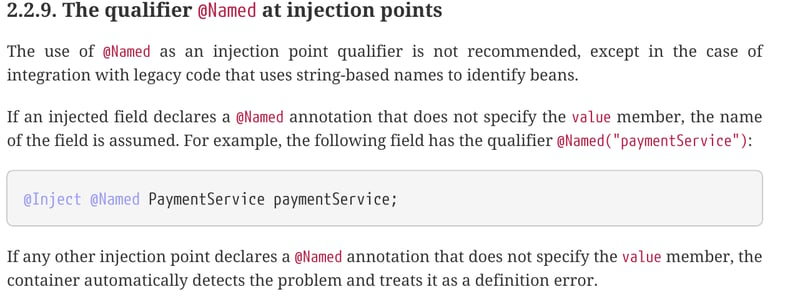ホームページ >Java >&#&チュートリアル >@Named で課題を明らかにする
@Named で課題を明らかにする
- WBOYWBOYWBOYWBOYWBOYWBOYWBOYWBOYWBOYWBOYWBOYWBOYWBオリジナル
- 2024-08-30 06:03:351308ブラウズ
コンテキストと依存関係の挿入 (CDI) の進化し続ける状況では、開発者は Bean の命名、デフォルトの実装、および潜在的な競合に関連するハードルに頻繁に遭遇します。この記事では、CDI の @Named アノテーションに関連する潜在的な落とし穴について詳しく説明します。私たちはその複雑さを掘り下げ、問題のあるシナリオに光を当て、SmallRye の @Identifier の使用を含む代替アプローチについて議論します。さらに、堅牢で保守可能な Jakarta EE
を構築するためのベスト プラクティスについての洞察も提供します。
アプリケーション。
@Default を理解する
@Default アノテーションは、特定の実装を特定のインターフェースまたは Bean タイプのデフォルトとして明示的にマークするための CDI の貴重なツールです。これは、同じインターフェースの複数の実装を扱うときに機能し、他の修飾子が使用されていない場合に、開発者がデフォルトでどの実装を挿入するかを指定できるようになります。
GreetingService インターフェイスの複数の実装が存在するシナリオを考えてみましょう。
@Default
public class DefaultGreetingService implements GreetingService {
@Override
public String greet(String name) {
return "Hello, " + name;
}
}
public class SpecialGreetingService implements GreetingService {
@Override
public String greet(String name) {
return "Greetings, " + name + "!";
}
}
修飾子を指定せずに Bean を注入する場合、CDI は @Default マークの付いた Bean をデフォルトとして使用します。これは、明確なデフォルトの選択肢を提供するため、複数の実装があるシナリオで有益です。
@Inject private GreetingService greetingService; // Injects the @Default implementation
@Default の使用はオプションですが、特に複数の実装があるインターフェースを扱う場合には、使用することを強くお勧めします。これにより、明確で一貫したデフォルト オプションが提供され、Bean インジェクション中のあいまいさや予期せぬ動作が防止されます。
@Named の探索 - 両刃の剣
@Named 修飾子は CDI で基本的な役割を果たし、人間が判読できる名前または識別子を Bean に割り当てます。開発者は、他のコンポーネントに Bean を注入するときに、Bean を名前で参照するためにこれをよく使用します。
ただし、@Named には、特に追加の修飾子なしで使用した場合、独自の一連の課題が伴います。デフォルトでは、CDI は非修飾クラス名を Bean 名として関連付けます。これにより、@Default 修飾子との競合が発生し、Bean インジェクション中に予期しない動作が発生する可能性があります。
@Named
public class MyBean {
// Implementation
}
明示的な修飾子を使用せずに MyBean を注入する場合、CDI は @Default 修飾子ではなく、@Named 修飾子のみを追加します。 @Default 修飾子は、Bean またはその修飾子で明示的に指定されている場合にのみ適用されます。
@Inject private MyBean myBean;
この場合、同じ型名を持つ他の Bean が存在すると、あいまいさが生じる可能性があります。たとえば、MyBean という名前の別の Bean がある場合、注入によりあいまいさが生じます。
この問題に対処するには、開発者は注入する Bean を明示的に修飾する必要があります。
@Inject
@Named("myBean")
private MyBean myBean;
あるいは、開発者は各 Bean のカスタム修飾子を利用して曖昧さを排除できます。
問題のあるケース: 曖昧さと意図しないデフォルト
追加の修飾子なしで @Named が使用され、同じ型の実装が複数存在する場合、あいまいさが発生します。次のシナリオを考えてみましょう:
@Named
public class ServiceA implements Service {
// Implementation
}
@Named
public class ServiceB implements Service {
// Implementation
}
明示的な修飾子を使用せずにサービスを注入すると、両方の Bean がタイプで一致し、名前や修飾子がそれらを区別しないため、あいまいさが生じる可能性があります。
@Inject private Service service;
この場合、CDI は @Default を暗黙的に追加したり、あいまいさを解決しようとしたりしないため、あいまいな依存関係が原因で注入が失敗します。
代替案: SmallRye Common からの @Identifier の導入
開発者は、@Named によってもたらされる課題を認識し、Bean の識別をより明示的に制御するための代替手段を模索することがよくあります。そのような代替手段の 1 つは、
の @Identifier アノテーションです。
スモールライ麦コモン。このアノテーションにより、Bean の命名に対するより明確で制御されたアプローチが提供され、競合や予期しないデフォルトのリスクが軽減されます。アプリケーションごとに一意の値を必要とする @Named とは対照的に、@Identifier では、タイプが異なる限り、同じ識別子の値を持つ複数の Bean が許可されます。この柔軟性は、同じインターフェイスまたは関連する型の異なる実装を処理する場合に特に役立ちます。
@Identifier を使用するには、単に Bean クラスにアノテーションを付けて、識別子の値を指定します。
@Identifier("payment")
public class DefaultPaymentProcessor implements PaymentProcessor {
// Implementation
}
@Identifier("payment")
public class LegacyPaymentGateway implements PaymentGateway {
// Implementation
}
@Identifier を使用した Bean の注入は簡単です。
public class Client {
@Inject
@Identifier("payment")
PaymentProcessor processor;
@Inject
@Identifier("payment")
PaymentGateway gateway;
}
ここでは、PaymentProcessor と PaymentGateway のタイプが異なるため、「payment」の @Identifier 値が複数の Bean で再利用されます。この柔軟性は @Named では許可されていません。
値はアプリケーション全体で一意である必要があります。
Another alternative to @Named is to create custom qualifiers. Custom qualifiers are user-defined annotations that can be used to identify and qualify beans. They offer the most granular control over bean selection and can be tailored to specific needs of the application.
To create a custom qualifier, follow these steps:
- Define a new annotation class.
- Annotate the annotation class with @Qualifier.
- Optionally, provide a default value for the qualifier.
For example, the following custom qualifier named DefaultPaymentGateway indicates the default payment gateway implementation:
@Qualifier
@Retention(RUNTIME)
@Target({METHOD, FIELD, PARAMETER, TYPE})
public @interface DefaultPaymentGateway {
}
To use the custom qualifier, annotate the bean class with it:
@DefaultPaymentGateway
public class StandardPaymentGateway implements PaymentGateway {
// Implementation
}
public class ExpressPaymentGateway implements PaymentGateway {
// Implementation
}
Then, inject the bean using the qualifier:
@Inject @DefaultPaymentGateway private PaymentGateway paymentGateway;
Choosing the Right Approach
The best approach for bean identification depends on the specific needs of the application. For simple applications, @Named may be sufficient. For more complex applications, @Identifier or
custom qualifiers offer more control and flexibility.
The following table summarizes the pros and cons of each approach:
| Approach | Pros | Cons |
|---|---|---|
| @Named | Simple, widely supported | Can be ambiguous, conflicts with @Default |
| @Identifier | Clearer identification, no conflicts with @Default | Requires additional annotations |
| Custom qualifiers | Maximum flexibility, fine-grained control | Requires upfront effort to define and maintain |
For further confirmation, you can refer to the official CDI specification

Conclusion: Strategic Choices for Bean Naming and Defaults
In conclusion, the potential pitfalls associated with @Named underscore the need for careful consideration when using this annotation in CDI. Ambiguity and unintended defaults can arise when relying on implicit naming, especially in the presence of multiple implementations. Developers are encouraged to explore alternatives such as @Identifier from SmallRye Common for a more controlled and explicit approach to bean identification. Embracing explicit qualification, custom qualifiers, and alternative approaches ensures a smoother and more controlled CDI experience, leading to robust and maintainable Java.
以上が@Named で課題を明らかにするの詳細内容です。詳細については、PHP 中国語 Web サイトの他の関連記事を参照してください。

